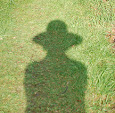John took this photo in Ayrshire last week. I am not sure of the location. Perhaps early morning on the River Girvan? I really like it! So different from his other outdoor photos!
It made me wonder "Is this not a fine example of 'chiaroscuro'?
It made me wonder "Is this not a fine example of 'chiaroscuro'?
I always understood the word to be related to light and dark. In English we use the Italian word to express this rather enigmatic term. It means light-dark. (In French it is clair-obscur.)

The word is mainly associated, and, indeed, comes from, the world of painting. It is to do with the artistic distribution of light and dark in a picture; how light (and dark) are used for dramatic effect.
 I see that there is even a sub-category called 'landscape chiaroscuro'. This is by Jan Both called Italianate Landscape with Travellers (1646).
I see that there is even a sub-category called 'landscape chiaroscuro'. This is by Jan Both called Italianate Landscape with Travellers (1646).
It was Rembrandt (and also Caravaggio* among others) who developed this special use of light in his painting. Indeed, there is a technique called 'Rembrandt lighting' which the above self-portrait illustrates.
There is an illuminated triangle under the eye, on the less illuminated side of the face. One side of the face is lit well from the main light source while the other side of the face uses the interaction of shadows and light, also known as chiaroscuro, to create this geometric form on the face.

In paintings dark subjects were dramatically lit by a shaft of light from a single constricted and often unseen source. The painting above is A Philosopher Giving a Lecture on the Orrery' by Joseph Wright of Derby (1766). It depicts a public lecture about a model solar system using a lamp.
Film-makers (and photographers) use chiaroscuro to indicate extreme low-key lighting in order to create distinct areas of light and darkness, especially when working in monochrome.
And for my fans ... well one fan, at least:
Pioneering movie director Cecil B. DeMille is credited with the first use of the term chiaroscuro. He explained in his autobiography that while shooting The Warrens of Virginia in 1915 he borrowed some portable spotlights from the Mason Opera House in downtown Los Angeles and “began to make shadows where shadows would appear in nature.”
When business partner Sam Goldwyn saw the film with only half an actor’s face illuminated, he feared the exhibitors would pay only half the price for the picture. After DeMille told him it was Rembrandt lighting, “Sam’s reply was jubilant with relief: for Rembrandt lighting the exhibitors would pay double!”
When business partner Sam Goldwyn saw the film with only half an actor’s face illuminated, he feared the exhibitors would pay only half the price for the picture. After DeMille told him it was Rembrandt lighting, “Sam’s reply was jubilant with relief: for Rembrandt lighting the exhibitors would pay double!”
_________________________________________________________________
* Why many of Caravagio's subjects were left-handed is looked at in light (oops... sorry about the pun ...) of his dramatic 'chiaroscuro' style of light and shadow. It was based on "a whole set of techniques that are the basis of photography"! Here.
All fine art photos are in the public domain.




2 comments:
This is a beautiful picture and a good explanation of chiaroscuro. I continue reading your interesting blog but now my daughter, who has a blog, is teaching me how to have my own - not an easy task! Hopefully my blog will be running by Tuesday since we are flying back home on Wednesday. There is so much to learn and I am afraid my blog will be so elementary. Today I am learning how to attach pictures. But we need a new computer at home. I'll read all your entries then. Cheers
Well, it seems we are all on the learning curve! I did not pick up your comment until today (Thursday) and I am not sure why I missed it!
Please email me! The address is in the ABOUT column on the right.
Post a Comment